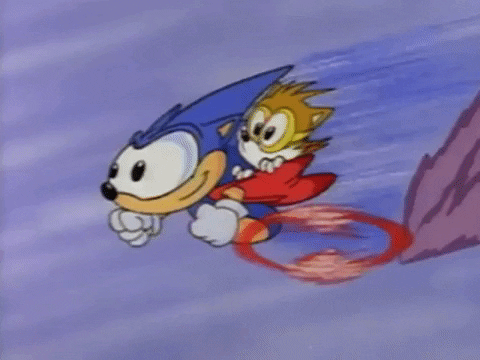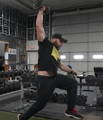What is 'speed training'?
Discussing speed involves a lot of different factors. The ultimate secret to speed training is a large, oversized, conceptual equation that readers can take with them, giving a great idea and concept of how to develop speed over time.

The first thing that must be done when you are a strength coach or an athlete is to understand the phases of sprinting. From the simplest form (think of a 100 m sprint, a 200 m sprint, 60 m sprint, or a 40-yard dash), we have to break it down into specific phases. There is the start. Basically how quickly an athlete can get out of the blocks and make that first step. There is then drive phase or acceleration, meaning how fast an athlete can go from the starting position to max speed. This transitions into holding max speed with maximal mechanics and slowing down the slowest. Whoever can hold max speed the longest will be the best sprinter when it comes to track sports typically.
The next step as strength coaches is understanding the mechanics, movements, and techniques involved in sprinting. Strength coaches need to have a firm understanding of the techniques used in the start, drive phase/acceleration, and maximal mechanics. Strength coaches also need to understand and know the muscle groups that need to coordinate rapidly through the different mechanics. Not only do coaches need to know the muscle groups and techniques through all the phases, but strength coaches also need to know the ranges of motions utilized in each phase of speed while sprinting. This gives coaches the lens to look through muscular physiology to be applied to specific sports to develop transient speed that varies by sport as well as the locomotion in movement.

With the first two things done, understanding the phases and the technique used (which gives us an understanding of the muscular physiology used) we can start to identify for specific sports what phases athletes will predominantly be in. For instance, a baseball player who hits a line drive to the outfield will be using the start phase to get out of the block, accelerating down first base, and rounding through the first base to head toward second. This means we will be looking through a lot of the running in the sport of baseball through the lens of acceleration and the start. A wide receiver, who will have a much different start position than a batter in baseball, which we will have to train, as well as accelerating, decelerating, cutting, and accelerating again.
Those are the key concepts that need to be hit right away. Look at speed through the lens of a sprinter, understand the actual technique and phases of sprinting, but then pull it back and apply it to specific sports.
The Breakdown
What are all the different moving pieces? We have to think about the phases of sprinting, the technique, the muscles, the range of motion, the speed of coordination, and then we have even more to do as a coach.
So if we have technique, as a coach we have to have technique drills, technique work to do in the weight room, and constantly refining the athlete’s technique to teach them how to move properly. Along with technique, we have power development or the engine of the athlete. Using technical coordination movements, absolute strength movements, and plyometric movements that have been shown through research to increase power related to sprinting.
Now when we analyze this, we have to see where our athletes have leaks. The leak stoppage contributes to the long-term development of athletes. For instance, New Zealand researchers spent a lot of time researching sled work, finding that doing technique drills used with sled drills to create a 50% velocity decrement through a load on a sled to increase potential ability to create a ton of power. In a very simple way, we can see it as the marriage of technique and power.
Technique Bucket
Talking about technique drills as exercises, we have to start to change the way we think. For instance, athletes who want to run faster sometimes just try as hard as possible. The effort is commendable, but not necessarily the best thing when lacking technique.
Some of the best things that can be done to improve technique are A skips, B skips, and simple ankle dribbling, as well as understanding how the feet should be grounding during the start and the drive phase.
We also have to understand that when training to improve speed, athletes at the highest levels in track events know exactly how many strides it takes them to get to max speed and how many strides it takes to complete the race. One thing we can learn from that world, especially with sports with planned movements, we can figure out how many steps to take before a cut and learn the technique to accelerate, decelerate, and accelerate again.
Sprinting on hills is also phenomenal. One of the best ways to improve speed is to just sprint on a hill. The hill demands a high knee drive and a forward lean. It teaches the body naturally how to accelerate rapidly. Face it, most sports speed is focused on starting and acceleration. Besides a hill, using a sled is legit as well.

Power Bucket
It comes back to the twitch force an athlete can have to execute the technique as fast and as powerful as possible. We want effective athletes who understand things like a hip lock. But focusing strictly on power development, the first place to start is with technical coordination movements.
First off, don’t use deadlifts to get faster. Simple strength movements like a back squat, front squat, and single-leg squats transfer very well to power development. To get the most transfer, we want to do the simple strength movements in conjunction with technical coordination movements like a high hang snatch, a two-box power snatch, a power clean, or a high hang clean. These are exercises that light up the posterior change, teach force absorption, and create a technical mindset.
Coaches shy away from teaching the technique of snatches and cleans. BOGUS! Snatches and cleans lead to greater mobility, specifically ankle mobility. With greater ankle mobility athletes can achieve better positions for acceleration. Absorbing a clean teaches the body dynamic trunk control which transfers over really well to power development as well as better control with technique.
Reflexive Strength Movements And Plyometrics
Reflexive strength movements are a combination of technique and power that teach the body how to accelerate really well to increase horizontal power development.
With that said, think about a really strong body. Someone who squats 500 lbs. That is great! But we have to play the game on a continuum. We have max strength on one end and technique on the other end. They are hypothetically on opposite ends but they are still connected. Within that connection, there is this idea of speed of coordination. We need to increase the speed of coordination as rapidly as possible so that the athlete can link the max strength closer to technical execution. This is where reflexive strength movements come into play.

Reflexive strength movements require reaction speeds even faster than technical coordination movements like a snatch or clean. A reflexive exercise is a little bit more advance. We can start off with a simple dumbbell snatch to a hip lock. The next step might be performing a drop snatch (force absorption) into a hip lock. We can then do the drop snatch with a step onto a box, and even quicker movement. The idea is to coordinate the posterior chain through the trunk and into the upper body.
Reflexive movements are key to moving down the power spectrum into the technical realm to increase speed. Plyometrics helps do this as well.
Increasing the horizontal ability to project is needed to be fast. There is a recent study where scientists studied sprinters and measured a sprint on one day with a warm-up that did not include plyometrics. The next day they measured the athletes’ sprint after the athletes did a plyometric warm-up. The experiment revealed that when athletes did plyometric movements in the warm-up they were drastically faster. That is a key concept.
When we do things like plyometrics it feeds into both the technique and power buckets. That is why the transfer of training with plyometrics is so high. It is important to understand how to use plyometrics in training, particularly frequency, so we don’t beat our athletes up to best increase athletes’ speed-based ability.
One exercise we like to use is Gwiz jumps into single-leg bounds over mini-hurdles. Another plyometric exercise we like to have athletes do loaded quarter squat jumps with dumbbells in hand, rest twenty to thirty seconds, and then perform a series of double leg bounds. As a quick aside, single-leg bounds and double-leg bounds are the best things to do to increase speed (it is also cheap, and by cheap we mean free to go outside and jump). Both exercises help the ability to recruit quickly. Athletes who recruit quickly develop a large amount of force to lead to superior horizontal projection.
Isolation
Understand that bodybuilding and isolation movements do play a role in increasing power development and understanding technical execution.
At Garage Strength, we call them hamstring pulls. Most people call them Nordic hamstring curls. Movements like this are phenomenal isolation movements that lead to increased rates of coordination. We will do hamstring pulls from different positions with different chest angles. We also do razor hamstring curls. Don’t shy away from bodybuilding movements.
We also love programming simple single-leg RDLs with dumbbells. The movement can even be done with a hip lock. Another movement we do is hamstring curls with floor sliders.

We want to have hip extension with knee flexion to make sure we use all three heads of the hamstring to coordinate them effectively. There is a place for bodybuilding movements and isolation movements that transfer really well to speed based training.
The Final Piece
Remember, with all this discussion we have power development on one end and technique on the other end. In between those two poles of the continuum, we have reflexive movements, plyometric movements, and the final key area is where all of this can be united.
Remember back to using sleds and increasing horizontal power? The study found that we can have athletes run a sprint unloaded and then cater back the speed by attaching a sled with enough weight to decrease the speed by 50%. So an athlete who runs 20 mph, needs to run 10 mph with the sled attached. Athletes can then be profiled by the weight on the sled. An athlete who is really weak may not need that heavy of a load to decrease the velocity decrement to 50%. A stronger athlete with poor technique might need a higher load. The higher load will force them to go slower and focus on executing proper technical movement.
The issue is that a lot of people don’t have access to the equipment to do that. Our solution is using a single-leg squat. For instance, for an athlete with 250 lbs single-leg squat PR, we will have the athlete drop down to 125 lbs on the bar (50%), or as we correlate with the sled, to an even lower number of about 95 lbs on the sled or even lower at 75 lbs. Play around with it.
Most of us don’t have access to the technology the scientists used. But we do have our brains and the ability to figure it out. Take notes of feelings while performing the movement. Record where soreness manifests the next day.
Recap
On one end is power and on the other end is technique. Use A skips, B skips, wicket runs, and hill sprints. Use absolute strength movements, technical coordination movements, reflexive strength movements, and plyometric movements. And then at the point where both worlds unite, use the sled exercises with velocity decrement to understand how athletes produce speed in their specific sport.
DANE MILLER
Dane Miller is the owner and founder of Garage Strength Sports Performance. He works with a select handful of clients on building comprehensive programs for fitness and nutrition. Several times a year he leads a workshop for coaches, trainers, and fitness enthusiasts.



Coach Dane, I love how you break everything down into its simplest form. I am a true believer of what you are saying. I was an assistant strength coach at UCLA in 2008 but was let go when they fired the HC. I needed to go back to school and finish up getting my BA degree. Now that I have my degree. I am looking to get back into the college sector. I am currently studying for my CSCS exam and going back to school to get my Master’s in Exercise Science and Injury Prevention. I also, have my USAW Level 1 certification. Thank you for all your great information and I will continue to follow you and hopefully get an opportunity to meet you one day. Have a great day coach.